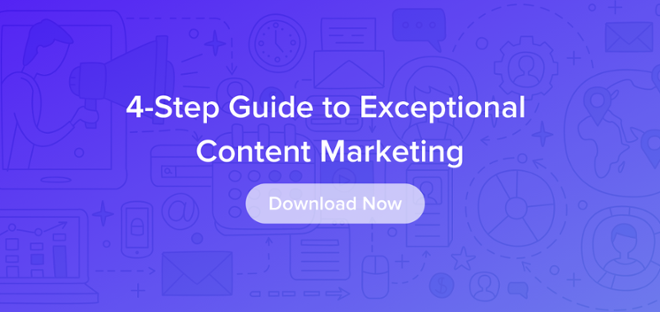 For as long as content has existed, there’s been bad content.
For as long as content has existed, there’s been bad content.
Content marketing has a pretty rich and interesting history, and marketers today may be improving their practices and the work they produce — but bad content has always been (and will always be) around.
That said, I can see for a second why some marketers or brand leaders aren’t terribly worried about fake news and its rise. Fake news content is bad content; you’re lucky (but are you really?) if you can make it through the first few lines of one of those pieces.
So what? Bad content has always existed, and as long as you’re not actively contributing to it by pushing out overly promotional, low-quality content, what do you really have to worry about?
When that bad content is blatantly biased, spammy, or unsubstantiated, you might give consumers the benefit of the doubt. They surely wouldn’t read it, believe it, share it with their networks, or act on it. Can’t they tell it’s not accurate, high-quality content?
I’ve got some news for you: They sometimes can’t.
Fake news is a real problem, and it has real consequences — for audiences, content marketers, publishers, and everyone with an uncle who knows how to use Facebook. Content creators and consumers are facing new challenges. To separate fact from fiction and maintain trust with your audiences, here’s what you should know.
Fact or Fiction?
Your audience members’ access to information doesn’t necessarily improve their ability to verify that information. If you’ve ever been fortunate enough to help an older family member figure out her smartphone or set up a Blu-ray player with Wi-Fi, you know that being “plugged in” and being “in the know” aren’t always synonymous.
Just like watching a movie on Netflix doesn’t make you an expert on all things streaming, consuming online content doesn’t make you a content expert. Research shows that your audience members are actually having a pretty hard time figuring out whether the content they’re consuming is real or fake, earned or bought, sponsored or contributed.
In its report on native advertising, Contently found that only 23 percent of respondents described the sponsored content they saw as advertising, and 44 percent weren’t able to correctly identify the sponsor of the native ad.
And it’s not just sponsored content that’s throwing readers for a loop. NPR reported on research from Stanford University that looked at how well students were able to assess the credibility of online information sources — and the results weren’t exactly display-on-the-fridge material.
The majority of high school students couldn’t tell the difference between a real news source and a fake one on Facebook, and more than 30 percent argued that the fake source was more trustworthy than the verified account.
Even most Stanford undergrads couldn’t tell the difference between mainstream and fringe sources. After spending up to 10 minutes using Google and on-site links to evaluate them, more than half concluded the fringe source — an organization classified as a hate group by the Southern Poverty Law Center — was the more reliable one.
Fueling the Fire
Misinformation isn’t new, and neither is the fact that audiences don’t always know how to separate it from the truth. Look no further than the checkout line at the grocery store for ye olde fake news in the form of “BELOVED CELEBRITY’S SECRET FAMILY SPEAKS OUT.” So why is fake news such a big deal now? Social media.
Pair changing social media platforms and their potential reach with someone’s inability to tell real and unreal content apart, and fake news can spread like wildfire. In fact, a BuzzFeed News analysis found that top-performing fake news on Facebook earned more engagement than the top stories from major publications in the months leading up to last year’s presidential election.
Election-related content might be the strongest example we have of fake news right now, but you can’t avoid its consequences simply by removing yourself from political conversations.
It’s more than the topic of the content that makes fake news damaging — it’s also the fact that it’s able to spread so quickly. Content consumers have already been exposed to fake news in one way or another, and its presence is chipping away at the trust they have in the media.
According to Gallup, fewer than one in three Americans has a “great deal” or “fair amount” of trust in the media — the lowest in Gallup’s polling history. Trust is already hard to earn. Fake news is making it harder to keep.
Trust and the Content Comeback
Fake news isn’t a signal of the end of content, just like its ability to spread isn’t a signal of social media’s failure. It presents important, but not impossible, challenges. Forward-thinking marketers and content creators are finding an opportunity, and Facebook is introducing plans to combat the problem on its platform.
Let’s start with the opportunity. When the trustworthiness of more traditional news media outlets is in question, the door for brands to step into the game is wide open. Joe Pulizzi and Robert Rose discussed this opportunity and the democratization of trust on a recent episode of “PNR: This Old Marketing.”
You might have an easier time leveraging the trust you’ve built with your audience to really enter and lead the conversations in your industry — especially if your target audience’s trust in major outlets has decreased. Your chance to build your thought leadership and shine as an industry influencer is greater.
Now, on to changes from Facebook. Whether you believe Facebook should fact-check the content on its platform or you believe that’s fixing a symptom, not the problem — feeling that fact-checking is really the responsibility of journalists and content creators — the decision has been made.
Facebook will fact-check fake news. Users will be able to report content as fake or misleading, which will prompt third-party fact-checkers to verify whether the content is fake. If it is, it’ll be labeled as fake and buried in users’ news feeds.
The rise and reach of fake news is important to acknowledge, but it definitely doesn’t mark the end of content. It doesn’t even mean we need to overhaul our content marketing practices entirely. But it does offer some important reminders.
Content is powerful. It’s your job to make sure it’s used for good. Maximize your headlines, and commit to sharing accurate, high-quality ideas in your content to deliver on the promises in those headlines. Remember what makes content go viral, and build content communities to grow your reach while maintaining trust. That’s really what it all comes down to: trust.
Need more tips on keeping your content engaging and high-quality? Download our easy four-step guide below!




 For as long as content has existed, there’s been bad content.
For as long as content has existed, there’s been bad content.



